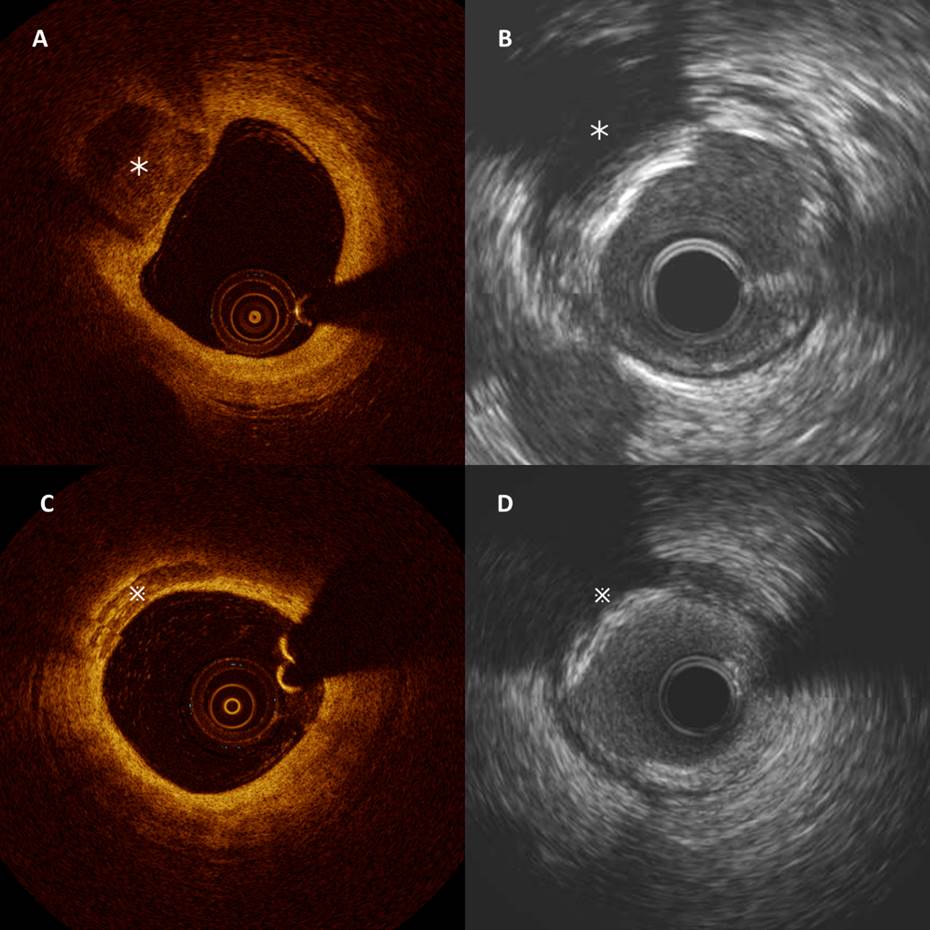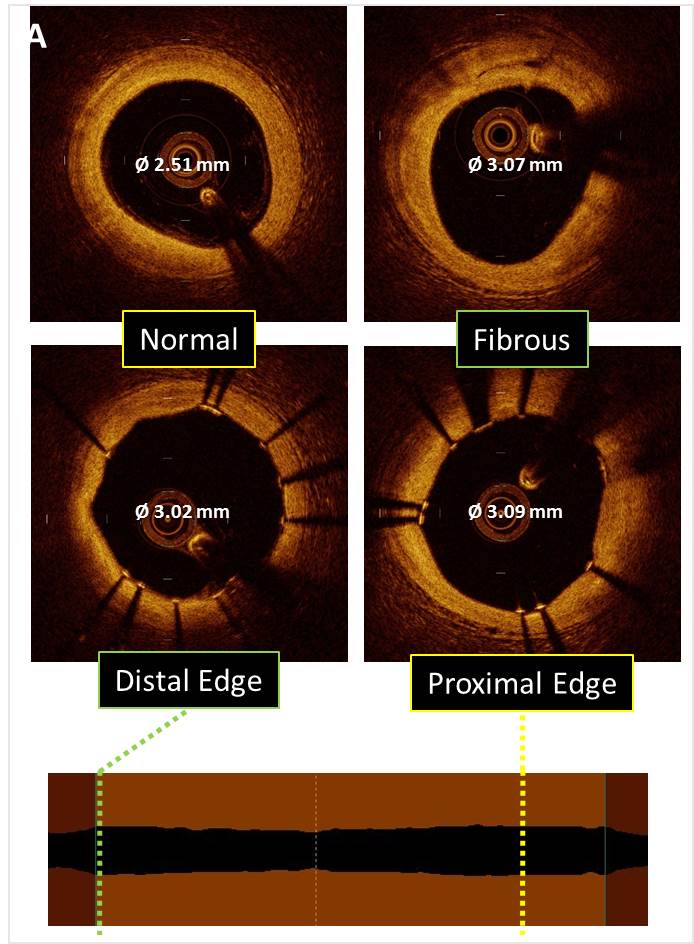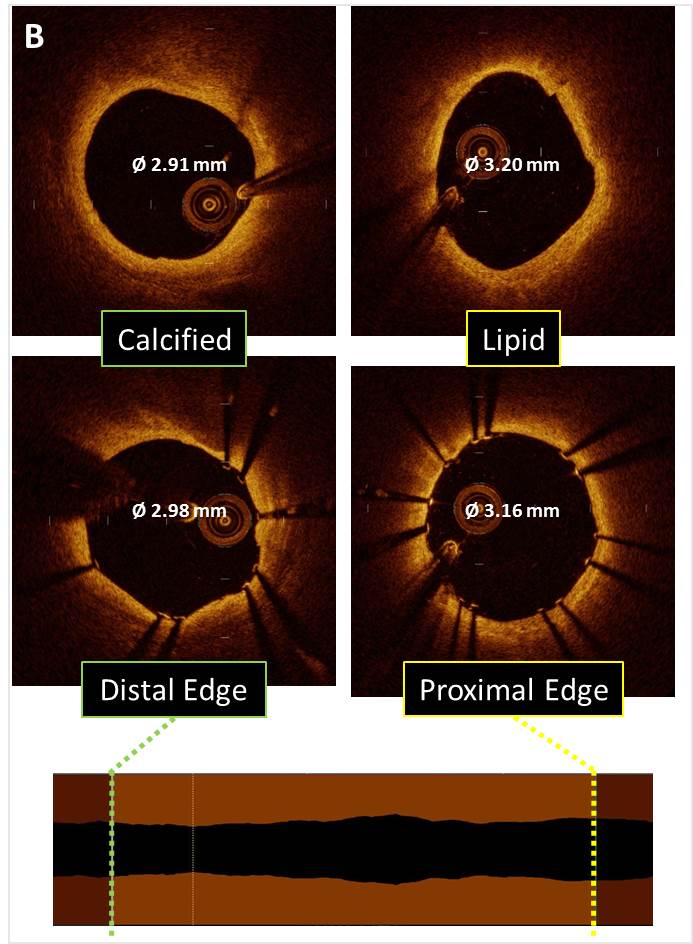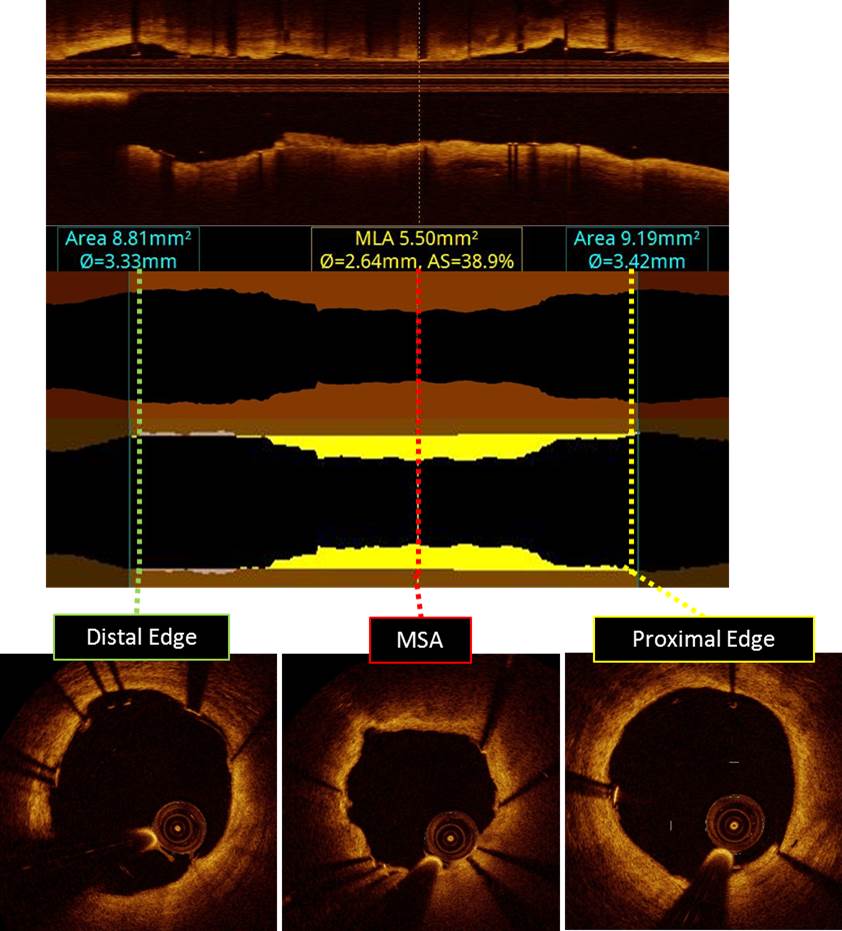Intravascular OCT in PCI
Editor's Note: This is Part I of a two-part Expert Analysis. Go to Part II.
Intravascular optical coherence tomography (OCT) can add value to angiography as a diagnostic and/or intervention tool for percutaneous coronary intervention (PCI) guidance. In diagnostic terms, it is essential to separate two very distinct populations: Stable coronary artery disease (CAD) and acute coronary syndromes (ACS). For both populations, the fundamental questions are the following: Is there a merit for intervention? If so, which vessel/lesion? In terms of procedure planning, intravascular OCT can help with planning every coronary intervention procedure. The following are common questions about lesion preparation: Is there a need for atherectomy? Is there a need for thrombectomy? If pre-dilatation is chosen over direct stenting, how aggressive should the procedure be (i.e., type of balloon [compliant, non-compliant, or scoring], balloon size, and pressure based on luminal references)? As for stent selection, what length (i.e., selecting the appropriate landing zone by avoiding landing stent in soft or calcified plaques to minimize potential edge dissections) and diameter are appropriate? Should you choose multiple stents or a single stent? If a need exists for overlapping stents, where is the best location? When it comes to stent optimization, the most studied metric related to outcomes post stent is stent expansion. Other potentially significant findings revealed by intravascular OCT after stent implantation are stent malapposition,1 edge dissections,2 and tissue prolapse.
Diagnostic Intravascular OCT
Stable CAD
Like intravascular ultrasound (IVUS), intravascular OCT is unable to accurately predict physiology when compared with today's gold standard, fractional flow reserve (FFR).3,4 The large spectrum of vessel sizes and microvascular recruitment precludes single cross-section lumen analysis to accurately assess the physiological significance of a lesion. Intravascular OCT-derived minimal lumen area (MLA) has a tendency to be smaller when compared with IVUS.5 We speculate that the higher resolution and contrast between lumen and vessel wall obtained with intravascular OCT allow for a more detailed lumen segmentation compared with IVUS, which is mostly pronounced in irregular calcified plaque segments. Reference vessel lumen analyses as well as perfect circular phantom models show excellent agreement between intravascular OCT and IVUS, with lower interobserver variability obtained with intravascular OCT.6 This again could be explained by the higher contrast between lumen and vessel wall because blood needs to be displaced with intravascular OCT. In addition, the higher resolution of the method allows for a more automated software segmentation of the lumen with less human input, leading to a higher reproducibility. Full volumetric lumen analysis by OCT outperformed single cross-section analysis.7 The ability of providing automated volumetric lumen segmentation is a potential differential of OCT versus current IVUS systems.
Dedicated investigation, mostly on IVUS literature, has been conducted to characterize the significance of left main disease based on anatomical features and lumen geometry. The rationale for this effort is that left main size tends to be more stable compared with all other vessels, and a "magic number" could achieve better reproducibility. However, there is a significant gray zone, with most acceptable numbers varying 4.8-6.0 mm2.8,9 We prioritize FFR assessment of left main disease over intravascular imaging. In situations of combined left main and proximal left anterior descending lesions in which the interpretation of the FFR pullback may be equivocal, both IVUS and intravascular OCT-derived MLA can be considered in the decision-making process. Intravascular OCT, however, is limited to distal bifurcation and left main body disease because ostium left main is not consistently imaged by intravascular OCT.10
Acute Coronary Syndromes
Intravascular OCT has unique features that favor its utilization in the setting of ACS. Intravascular OCT has 100% sensitivity (vs. 33% sensitivity of IVUS) in detecting intraluminal thrombus when compared with coronary angioscopy.11 The high sensitivity of the method in detecting thrombus can fulfill angiographic limitations in differentiating thrombus from calcium and others etiologies of ambiguous angiographic radiolucency. Intravascular OCT is considered the gold standard method for fibrous cap rupture detection11 and has twice the sensitivity of IVUS. Several reports indicate the ability of the method in discriminating the underlying mechanism of the ACS,12 which can directly impact the management strategy.13,14 The method is also very suitable for the detection of non-CAD-related ACS causes like spontaneous coronary artery dissection; in this particular clinical setting, intravascular OCT-derived information could defer unnecessary stenting. These characteristics make it the ideal method for defining the etiology and anatomic location of the culprit vessel/segment or ruling out ACS.
Procedure Planning
Lesion Preparation
Calcium is the most important predictor of suboptimal stent expansion. Although IVUS and intravascular OCT have similar sensitivity for detecting calcium,15 intravascular OCT has high tissue penetration on calcium, which allows for the assessment of calcium thickness (Figure 1). Concentric but thin calcium can be fractured by regular or scoring balloons. In the setting of concentric and thicker calcium, however, atherectomy should be considered. Another strategy is to perform more aggressive pre-dilatation with nominal vessel size non-compliant balloons. Unfortunately, at the moment there are no specific cut-off values to indicate the need for atherectomy or aggressive pre-dilatation. However, as previously discussed, it is easier to achieve adequate stent expansion with good plaque modification than react to grossly under-expanded stents. The need for careful lesion preparation seems to be even more important with the first generation of bioresorbable scaffolds.16 These devices have much thicker struts and mass compared with the actual thin struts metallic stents that can be considered scoring devices by definition. The ability to embed struts in the wall with bioresorbable scaffolds is reduced, and lesion preparation with calcium debulking or creation of dissection plans in the plaque is key in order to achieve ideal expansion.
Figure 1: Calcium; Intravascular OCT Versus IVUS
Stent Selection
Current metallic stents can be expanded an average of 1.5 mm in diameter over their nominal size. Consequently, initial diameter selection can be extensively modified with post dilatation. This not true for the first generation bioresorbable scaffolds that generally should not be expanded over 0.5 mm from their nominal value. Therefore, appropriate diameter selection is particularly important with bioresorbable scaffolds. Diameter selection with intravascular OCT is dictated by the smallest reference vessel diameter, which is usually the distal reference. Depending on the "quality" of the landing zone, different degrees of diameter oversizing can be applied. In "close-to-normal" vessels or concentric predominantly fibrotic lesions, we recommend 0.25-0.5 mm stent diameter oversizing. When a stent/scaffold is oversized, it should be deployed at no more than the nominal pressure. Although landing zones with eccentric calcified or lipid-rich plaque should be usually avoided, due to the diffuse nature of CAD, this is sometimes not possible; in this setting, nominal 1:1 sizing is preferable in order to avoid edge dissections2 (Figure 2). Be aware that when performing stent selection guided by intravascular imaging in very stenotic lesions, the catheter may be occlusive, and the distal reference may be undersized due to under pressurized vessel. In this situation, pre-dilatation should precede intravascular imaging for sizing. Furthermore, it is mandatory to always perform administration of intracoronary nitroglycerin before sizing with intravascular imaging.
Figure 2: Stent Sizing
Stent length selection on intravascular OCT is determined mostly by volumetric assessment of the lumen area profile and adding a minimum of 3 mm to the total length (Figure 3). The quality of the landing zone may influence length selection. Avoiding landing in eccentric calcium or lipid-rich plaques may prevent edge dissections2 and longitudinal geographic miss.17 The very fast pullback acquisition obtained with intravascular OCT makes the method very precise for length measurements because it is less susceptible to heart movements, and the combination of full automated volumetric lumen segmentation and features like angiography co-registration facilitate stent length selection.
Stent Optimization
After adequate stent planning with intravascular OCT, the post-stent implantation image will determine the potential need for additional steps. Typically, the post-stenting intravascular OCT pullback happens after high-pressure implant or after high-pressure post dilatation with a nominal diameter non-compliant shorter balloon. The need for high-pressure stent implantation is strongly established;18-20 consequently, intravascular image can follow this step. There are a number of potential aspects to look for with intravascular OCT after stent implantation; the most important is stent expansion.
Edge Dissections and Tissue Prolapse
Intravascular OCT has a very high sensitivity for edge dissections,2 and operators should not overreact to it. The vast majority of edge dissections heal without clinical consequences.2 The best situation is to avoid edge dissections by finding a good landing zone while performing appropriate stent diameter selection. Only in the presence of intramural hematoma should an additional stent be placed to seal the dissection in order to avoid vessel collapse.2 Tissue prolapse happens more often with lipid-rich plaque or in ACS with atherothrombotic material. Unfortunately, there is no clear guidance on how to react to this finding. Anecdotal data of prolonged nominal pressure balloon inflation for "stabilizing" the tissue have been reported.21
Stent Malapposition
Stent malapposition is qualitatively defined as lack of contact of stent struts with the vessel wall in non-bifurcated segments.22 The high-resolution nature of intravascular OCT unravels malapposition frequently. As discussed, the clinical significance of malapposition is unknown. Late acquired malapposition is apparently an epiphenomenon that results from tissue necrosis, inflammation (with positive remodeling); it has been reported frequently at sites of stent thrombosis.1,23 This is different from implant-related stent malapposition, which apparently has no or minor impact on outcomes. Equally important is the nature of malapposition. A stent that is circumferentially malapposed is always a consequence of stent/vessel size mismatch. In contrast, a focal, non-circumferential area of malapposition or even a single malapposed strut is often the result of inability of the stent to conform to irregularities in the lumen contour, typically related to calcium in the vessel wall. There is little the operator can do to solve malappositions that are conformability related; the fundamental concern with these segments is if the stent is well expanded. For malapposition that results from stent/vessel size mismatch, a bigger compliant balloon at nominal or even lower pressure would be able to appose the stent to the vessel wall.
Stent Expansion
This is the single most important parameter that has been correlated with clinical outcomes.18,20 Different from malapposition, it should always be approached in a quantitative fashion. In order to determine under-expansion, a reference vessel lumen diameter has to be considered. If in any given region of the stented segment the lumen area is inferior to the reference area, this is considered a region of under-expansion. It is a continuous metric, and there is no magic number, but the general rule should be the following: the least under-expansion one may achieve in a safe way the better. There are more similarities than differences between IVUS and intravascular OCT when assessing expansion. Both IVUS and intravascular OCT rely on lumen assessment quantification to optimize the expansion results. Intravascular OCT has the advantage of automatically segmenting all frames and determining not only the reference vessel size but also the minimal stent area (Figure 3). Conversely, with IVUS the operator should first qualitatively select the cross section in which under-expansion is suspected and then follow with measurement. Additional post dilatation with non-compliant balloon of nominal size at very high pressure should be performed to resolve or improve areas of under-expansion. Larger diameter balloons should be applied only in situations of vessel tapering at bifurcation and proximal stented segments.
Figure 3: Post-Stent Lumen Profile
IVUS Versus Intravascular OCT
IVUS was originally introduced in late 1980s and intravascular OCT in the early 2000s. The more than two decades between these two technologies makes comparison difficult. Over the years, the field has evolved with new concepts and devices, and IVUS was instrumental along the journey, like the broad adoption of stent implantation at high pressures. IVUS was also able to accumulate a tremendous amount of evidence favoring intravascular imaging over angiography alone. Intravascular OCT should capitalize on metrics and concepts that are interchangeable between the two imaging modalities and, at the same time, continue to evolve the field with new metrics that are better depicted or obtained with intravascular OCT. IVUS-guided PCI is essentially a post stent assessment/optimization tool. In this regard, the central parameter is lumen assessment, and this is translatable between the two methods. Not surprisingly, as documented by ILUMIEN II (Observational Study of Optical Coherence Tomography [OCT] in Patients Undergoing Fractional Flow Reserve [FFR] and Percutaneous Coronary Intervention), both methods achieved a similar percentage of stent expansion when operators apply IVUS concepts to intravascular OCT.24 We believe that intravascular OCT should position itself as a periprocedural tool to take full advantage of the superior plaque characterization, ACS applications, stent planning, and volumetric lumen segmentation for stent optimization. Every coronary intervention can potentially benefit from intravascular OCT, and this advantage is even more pronounced with less-forgiving devices like bioresorbable scaffolds. Current commercially available systems from St. Jude Medical and Terumo have overall similar performance and can be considered the third generation of the method.
Conclusions
In order for patients to benefit from either IVUS- or OCT-guided stent implantation, it is necessary for the interventional cardiologist to be able to fulfill three basic requirements:
- Proper image acquisition
- Accurate image interpretation, which requires that images be acquired properly
- Correct decision-making based on accurate image interpretation
Particularly with a new method like OCT, but also with a more mature technology like IVUS, training and education are critical.
Thus, the question of IVUS versus OCT is wrong and, in fact, belies the true conundrum. Although there are clear differences between the two technologies—resolution and surface detail favoring OCT, penetration and media-to-media sizing favoring IVUS, fine details favoring OCT, the bulk of clinical data favoring IVUS—better questions are IVUS or OCT versus angiography alone and why these technologies are so underutilized given the evidence that has been presented in both of our cases and the fact that the major determinants of optimal stent implantation can be assessed better by either IVUS or OCT than by angiography alone.
References
- Attizzani GF, Capodanno D, Ohno Y, Tamburino C. Mechanisms, pathophysiology, and clinical aspects of incomplete stent apposition. J Am Coll Cardiol 2014;63:1355-67.
- Chamié D, Bezerra HG, Attizzani GF, et al. Incidence, predictors, morphological characteristics, and clinical outcomes of stent edge dissections detected by optical coherence tomography. JACC Cardiovasc Interv 2013;6:800-13.
- Nascimento BR, de Sousa MR, Koo BK, et al. Diagnostic accuracy of intravascular ultrasound-derived minimal lumen area compared with fractional flow reserve--meta-analysis: pooled accuracy of IVUS luminal area versus FFR. Catheter Cardiovasc Interv 2014;84:377-85.
- Stefano GT, Bezerra HG, Attizzani G, et al. Utilization of frequency domain optical coherence tomography and fractional flow reserve to assess intermediate coronary artery stenoses: conciliating anatomic and physiologic information. Int J Cardiovasc Imaging 2011;27:299-308.
- Bezerra HG, Attizzani GF, Sirbu V, et al. Optical coherence tomography versus intravascular ultrasound to evaluate coronary artery disease and percutaneous coronary intervention. JACC Cardiovasc Interv 2013;6:228-36.
- Tahara S, Bezerra HG, Baibars M, et al. In vitro validation of new Fourier-domain optical coherence tomography. EuroIntervention 2011;6:875-82.
- Guagliumi G, Sirbu V, Petroff C, et al. Volumetric assessment of lesion severity with optical coherence tomography: relationship with fractional flow. EuroIntervention 2013;8:1172-81.
- Jasti V, Ivan E, Yalamanchili V, Wongpraparut N, Leesar MA. Correlations between fractional flow reserve and intravascular ultrasound in patients with an ambiguous left main coronary artery stenosis. Circulation 2004;110:2831-6.
- Kang SJ, Lee JY, Ahn JM, et al. Intravascular ultrasound-derived predictors for fractional flow reserve in intermediate left main disease. JACC Cardiovasc Interv 2011;4:1168-74.
- Fujino Y, Bezerra HG, Attizzani GF, et al. Frequency-domain optical coherence tomography assessment of unprotected left main coronary artery disease-a comparison with intravascular ultrasound. Catheter Cardiovasc Interv 2013;82:E173-83.
- Kubo T, Imanishi T, Takarada S, et al. Assessment of culprit lesion morphology in acute myocardial infarction: ability of optical coherence tomography compared with intravascular ultrasound and coronary angioscopy. J Am Coll Cardiol 2007;50:933-9.
- Guagliumi G, Capodanno D, Saia F, et al. Mechanisms of atherothrombosis and vascular response to primary percutaneous coronary intervention in women versus men with acute myocardial infarction: results of the OCTAVIA study. JACC Cardiovasc Interv 2014;7:958-68.
- Stefano GT, Bezerra HG, Mehanna E, et al. Unrestricted utilization of frequency domain optical coherence tomography in coronary interventions. Int J Cardiovasc Imaging 2013;29:741-52.
- Wijns W, Shite J, Jones MR, et al. Optical coherence tomography imaging during percutaneous coronary intervention impacts physician decision-making: ILUMIEN I study. Eur Heart J 2015;36:3346-55.
- Kume T, Akasaka T, Kawamoto T, et al. Assessment of coronary arterial plaque by optical coherence tomography. Am J Cardiol 2006;97:1172-5.
- Serruys PW, Ormiston JA, Onuma Y, et al. A bioabsorbable everolimus-eluting coronary stent system (ABSORB): 2-year outcomes and results from multiple imaging methods. Lancet 2009;373:897-910.
- Costa MA, Angiolillo DJ, Tannenbaum M, et al. Impact of stent deployment procedural factors on long-term effectiveness and safety of sirolimus-eluting stents (final results of the multicenter prospective STLLR trial). Am J Cardiol 2008;101:1704-11.
- Liu X, Doi H, Maehara A, et al. A volumetric intravascular ultrasound comparison of early drug-eluting stent thrombosis versus restenosis. JACC Cardiovasc Interv 2009;2:428-34.
- Görge G, Haude M, Ge J, et al. Intravascular ultrasound after low and high inflation pressure coronary artery stent implantation. J Am Coll Cardiol 1995;26:725-30.
- Hong MK, Mintz GS, Lee CW, et al. Intravascular ultrasound predictors of angiographic restenosis after sirolimus-eluting stent implantation. Eur Heart J 2006;27:1305-10.
- Cook JR, Mhatre A, Wang FW, Uretsky BF. Prolonged high-pressure is required for optimal stent deployment as assessed by optical coherence tomography. Catheter Cardiovasc Interv 2014;83:521-7.
- Bezerra HG, Costa MA, Guagliumi G, Rollins AM, Simon DI. Intracoronary optical coherence tomography: a comprehensive review clinical and research applications. JACC Cardiovasc Interv 2009;2:1035-46.
- Guagliumi G, Sirbu V, Musumeci G, et al. Examination of the in vivo mechanisms of late drug-eluting stent thrombosis: findings from optical coherence tomography and intravascular ultrasound imaging. JACC Cardiovasc Interv 2012;5:12-20.
- Maehara A, Ben-Yehuda O, Ali Z, et al. Comparison of Stent Expansion Guided by Optical Coherence Tomography Versus Intravascular Ultrasound: The ILUMIEN II Study (Observational Study of Optical Coherence Tomography [OCT] in Patients Undergoing Fractional Flow Reserve [FFR] and Percutaneous Coronary Intervention). JACC Cardiovasc Interv 2015;8:1704-14.
Keywords: Acute Coronary Syndrome, Angiography, Angioscopy, Atherectomy, Coronary Artery Disease, Coronary Vessel Anomalies, Dilatation, Hematoma, Inflammation, Lipids, Nitroglycerin, Observer Variation, Percutaneous Coronary Intervention, Prolapse, Stents, Thrombectomy, Thrombosis, Tomography, Optical Coherence, Vascular Diseases
< Back to Listings




